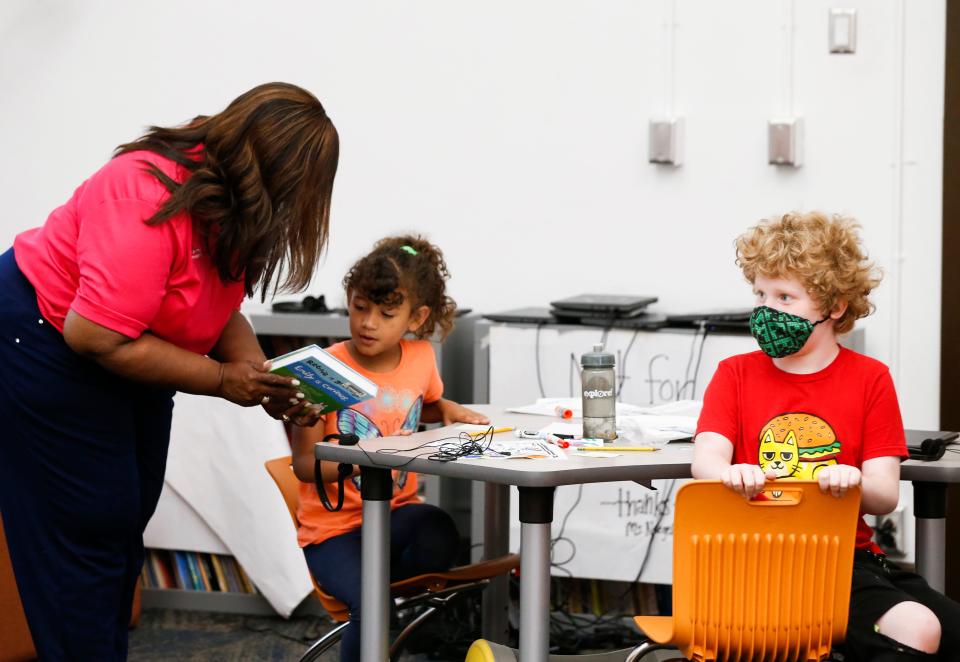'Baseline' tests show most SPS students started year below grade level in reading, math
Results of an internal assessment made public Tuesday showed how much work will be needed to get a majority of Springfield students on track in reading and math by the end of the 2022-23 school year.
Not quite 45 percent of students started the school year at or above grade level in English language arts or reading. Only 38 percent met expectations in math.

Superintendent Grenita Lathan championed the adoption of a new universal screener called Galileo to replace iReady. The internal exam provides a measure of academic progress for all K-12 students at the start, middle and end of each school year.
More:Missouri changes enrollment, funding and testing rules for full-time virtual learners
That, in turn, helps teachers identify what academic skills are missing and which students need extra help.
"Tonight establishes the baseline in looking at where our students are at this moment in time," she said at the school board meeting Tuesday. "In the middle of the year, we'll look and see if we've been able to grow students or to provide the resources that students need."
The district results were broken out by grade level in reading and math and by student demographics. They were not broken out by school, teacher or individual student.
"The purpose of tonight was to start the discussion around student achievement," Lathan said.
To the teachers and staff, Lathan said: "I appreciate the efforts that have been put into getting us where we are today. I am thankful to our principals and our teachers and everyone that has truly just bought into understanding that we need to use data to drive instruction and make informed decisions."
Board member Steve Makoski said the Galileo program will help the district measure academic achievement and hold educators accountable for results.

"I really am pleased with what I hear and what I see. I think the real test is going to be the middle of the year and the end of the year and I am just hoping we can have that benchmark with DESE and these scores to find out are we really performing better in comparison to other school districts," Makoski said.
The Missouri Department of Elementary and Secondary Education, or DESE, oversees state-mandated exams each year in reading and math in grade 3-8 and end-of-course exams in high school.
Last month, the state released the results of 2021 exams, which showed 43% of students were at grade level in reading and 38% were at grade level in math. A breakdown of the 2021 state test scores by district and school will be released in December.
The state-mandated exams show how Springfield students perform compared to the state average and other districts and schools. In contrast, the results of the internal Galileo exams, which are not compared to other districts, give the district a way to measure progress throughout the year.
Nicole Holt, deputy superintendent of academics, said Galileo results are a way to guide, not judge, progress and they provide quick feedback to teachers about where students are performing compared to expectations set by the district, which are aligned to the Missouri learning standards.
More:With scores lagging, Missouri gets $2.5 million grant to revamp student math testing
Since the internal exams are tied to those standards, the district said they are predictive of how students may score on state-mandated exams. The annual state exams are administered in the spring.
The beginning-of-year exams were given in late August and early September to establish a baseline and identify initial gaps in what students are expected to know and be able to demonstrate at their grade level.

"When we use classroom assessments specifically to inform instruction, we see results so it doubles the expected rate of learning for our kids," Holt said. "We are in a situation where we need to support students with accelerated learning in classrooms across our system."
Holt said the results of the initial exams cannot be compared to student performance in prior years.
"This is the very first time we're doing it so it's important to keep that in mind," she said. "It's our baseline for student mastery."
The results show how many students are proficient or advanced, which is at grade level or beyond. It also shows how many score in the basic or below categories, meaning they are one or more years behind the expectations for their current grade level.
At the meeting, the district announced its preliminary enrollment, preschool through grade 12, was 24,231 and, so far, nearly 54% qualify for free or reduced price meals, a national measure of poverty. However, that percentage may grow as applications are still being processed.
The demographic breakdown is 70% white, 9.1% Hispanic, 8.6% Black, 6.8% multiple races, 3.2% Asian. Other groups made up less than 1% each.
Reading
Overall results in the district for English language arts, or reading: 30.3% were proficient and 14.6% were advanced compared to 34.9% basic and 20.2% below basic.
Kindergarten − 39%
First grade − 41%
Second grade − 40%
Third grade − 42.4%
Fourth grade − 43.8%
Fifth grade − 46.2%
Sixth grade − 41.3%
Seventh grade − 40.6%
Eighth grade − 50.6%
Freshman year − 50.9%
Sophomore year − 54%
Junior year − 52.4%
Senior year − 50.1%
A look at students performing at grade level by subgroups: 57.2% Asian, 48.8% white, 43.5% American Indian, 38.6% multiple races, 34.5% Hispanic, 32.1% Pacific Islander, and 25.7% Black.
By lunch status, the level of students reading at grade level: 59.7% full pay, 42.1% reduced-price, and 30.1% free.
Math
Overall results in the district for math: 21.3% proficient and 16.7% advanced compared to 28.9% basic and 33% below basic.
Kindergarten − 34.8%
First grade − 35.1%
Second grade − 35%
Third grade − 36.1%
Fourth grade − 36.3%
Fifth grade − 36.3%
Sixth grade − 34.8%
Seventh grade − 40.8%
Eighth grade − 32.1%
Algebra I − 27.9%
Algebra II − 27.9%
Geometry − 94.4%
A look at students performing at grade level in math by subgroups: 51.7% Asian, 41.4% white, 30.9% for American Indian, 29.6% each for multiple races and Pacific Islander, 27,6% for Hispanic, and 22.8% for Black.
By lunch status, students performing at grade level in math: 51% full pay, 36.8% reduced-price, and 25.1% free.
Claudette Riley is the education reporter for the News-Leader. Email news tips to criley@news-leader.com.
This article originally appeared on Springfield News-Leader: Baseline testing shows most SPS students started behind grade level

